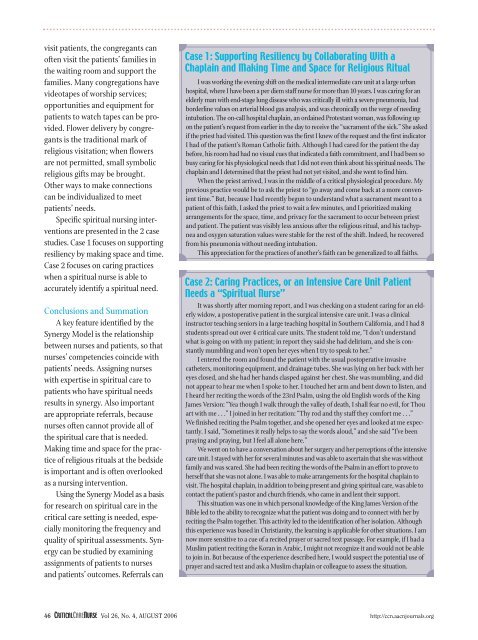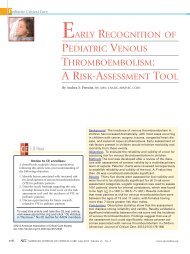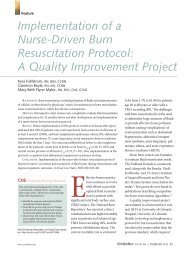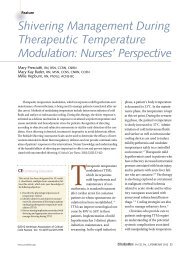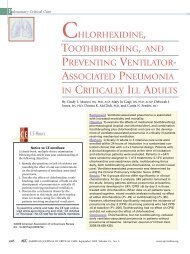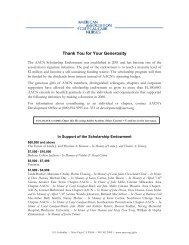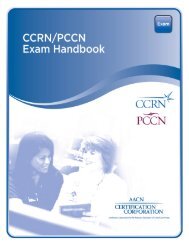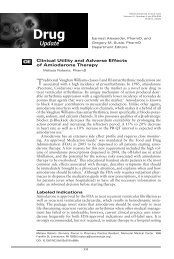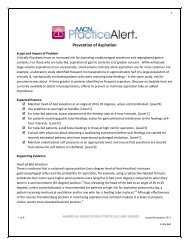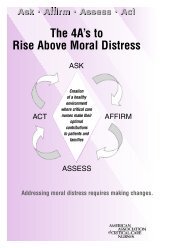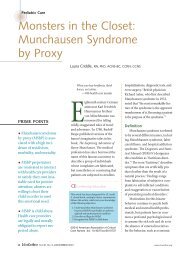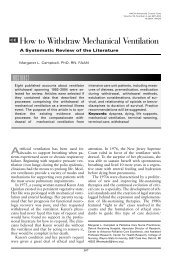Using the Synergy Model to Provide Spiritual Nursing Care in ...
Using the Synergy Model to Provide Spiritual Nursing Care in ...
Using the Synergy Model to Provide Spiritual Nursing Care in ...
You also want an ePaper? Increase the reach of your titles
YUMPU automatically turns print PDFs into web optimized ePapers that Google loves.
visit patients, <strong>the</strong> congregants can<br />
often visit <strong>the</strong> patients’ families <strong>in</strong><br />
<strong>the</strong> wait<strong>in</strong>g room and support <strong>the</strong><br />
families. Many congregations have<br />
videotapes of worship services;<br />
opportunities and equipment for<br />
patients <strong>to</strong> watch tapes can be provided.<br />
Flower delivery by congregants<br />
is <strong>the</strong> traditional mark of<br />
religious visitation; when flowers<br />
are not permitted, small symbolic<br />
religious gifts may be brought.<br />
O<strong>the</strong>r ways <strong>to</strong> make connections<br />
can be <strong>in</strong>dividualized <strong>to</strong> meet<br />
patients’ needs.<br />
Specific spiritual nurs<strong>in</strong>g <strong>in</strong>terventions<br />
are presented <strong>in</strong> <strong>the</strong> 2 case<br />
studies. Case 1 focuses on support<strong>in</strong>g<br />
resiliency by mak<strong>in</strong>g space and time.<br />
Case 2 focuses on car<strong>in</strong>g practices<br />
when a spiritual nurse is able <strong>to</strong><br />
accurately identify a spiritual need.<br />
Conclusions and Summation<br />
A key feature identified by <strong>the</strong><br />
<strong>Synergy</strong> <strong>Model</strong> is <strong>the</strong> relationship<br />
between nurses and patients, so that<br />
nurses’ competencies co<strong>in</strong>cide with<br />
patients’ needs. Assign<strong>in</strong>g nurses<br />
with expertise <strong>in</strong> spiritual care <strong>to</strong><br />
patients who have spiritual needs<br />
results <strong>in</strong> synergy. Also important<br />
are appropriate referrals, because<br />
nurses often cannot provide all of<br />
<strong>the</strong> spiritual care that is needed.<br />
Mak<strong>in</strong>g time and space for <strong>the</strong> practice<br />
of religious rituals at <strong>the</strong> bedside<br />
is important and is often overlooked<br />
as a nurs<strong>in</strong>g <strong>in</strong>tervention.<br />
<strong>Us<strong>in</strong>g</strong> <strong>the</strong> <strong>Synergy</strong> <strong>Model</strong> as a basis<br />
for research on spiritual care <strong>in</strong> <strong>the</strong><br />
critical care sett<strong>in</strong>g is needed, especially<br />
moni<strong>to</strong>r<strong>in</strong>g <strong>the</strong> frequency and<br />
quality of spiritual assessments. <strong>Synergy</strong><br />
can be studied by exam<strong>in</strong><strong>in</strong>g<br />
assignments of patients <strong>to</strong> nurses<br />
and patients’ outcomes. Referrals can<br />
Case 1: Support<strong>in</strong>g Resiliency by Collaborat<strong>in</strong>g With a<br />
Chapla<strong>in</strong> and Mak<strong>in</strong>g Time and Space for Religious Ritual<br />
I was work<strong>in</strong>g <strong>the</strong> even<strong>in</strong>g shift on <strong>the</strong> medical <strong>in</strong>termediate care unit at a large urban<br />
hospital, where I have been a per diem staff nurse for more than 10 years. I was car<strong>in</strong>g for an<br />
elderly man with end-stage lung disease who was critically ill with a severe pneumonia, had<br />
borderl<strong>in</strong>e values on arterial blood gas analysis, and was chronically on <strong>the</strong> verge of need<strong>in</strong>g<br />
<strong>in</strong>tubation. The on-call hospital chapla<strong>in</strong>, an orda<strong>in</strong>ed Protestant woman, was follow<strong>in</strong>g up<br />
on <strong>the</strong> patient’s request from earlier <strong>in</strong> <strong>the</strong> day <strong>to</strong> receive <strong>the</strong> “sacrament of <strong>the</strong> sick.” She asked<br />
if <strong>the</strong> priest had visited. This question was <strong>the</strong> first I knew of <strong>the</strong> request and <strong>the</strong> first <strong>in</strong>dica<strong>to</strong>r<br />
I had of <strong>the</strong> patient’s Roman Catholic faith. Although I had cared for <strong>the</strong> patient <strong>the</strong> day<br />
before, his room had had no visual cues that <strong>in</strong>dicated a faith commitment, and I had been so<br />
busy car<strong>in</strong>g for his physiological needs that I did not even th<strong>in</strong>k about his spiritual needs. The<br />
chapla<strong>in</strong> and I determ<strong>in</strong>ed that <strong>the</strong> priest had not yet visited, and she went <strong>to</strong> f<strong>in</strong>d him.<br />
When <strong>the</strong> priest arrived, I was <strong>in</strong> <strong>the</strong> middle of a critical physiological procedure. My<br />
previous practice would be <strong>to</strong> ask <strong>the</strong> priest <strong>to</strong> “go away and come back at a more convenient<br />
time.” But, because I had recently begun <strong>to</strong> understand what a sacrament meant <strong>to</strong> a<br />
patient of this faith, I asked <strong>the</strong> priest <strong>to</strong> wait a few m<strong>in</strong>utes, and I prioritized mak<strong>in</strong>g<br />
arrangements for <strong>the</strong> space, time, and privacy for <strong>the</strong> sacrament <strong>to</strong> occur between priest<br />
and patient. The patient was visibly less anxious after <strong>the</strong> religious ritual, and his tachypnea<br />
and oxygen saturation values were stable for <strong>the</strong> rest of <strong>the</strong> shift. Indeed, he recovered<br />
from his pneumonia without need<strong>in</strong>g <strong>in</strong>tubation.<br />
This appreciation for <strong>the</strong> practices of ano<strong>the</strong>r’s faith can be generalized <strong>to</strong> all faiths.<br />
Case 2: Car<strong>in</strong>g Practices, or an Intensive <strong>Care</strong> Unit Patient<br />
Needs a “<strong>Spiritual</strong> Nurse”<br />
It was shortly after morn<strong>in</strong>g report, and I was check<strong>in</strong>g on a student car<strong>in</strong>g for an elderly<br />
widow, a pos<strong>to</strong>perative patient <strong>in</strong> <strong>the</strong> surgical <strong>in</strong>tensive care unit. I was a cl<strong>in</strong>ical<br />
<strong>in</strong>struc<strong>to</strong>r teach<strong>in</strong>g seniors <strong>in</strong> a large teach<strong>in</strong>g hospital <strong>in</strong> Sou<strong>the</strong>rn California, and I had 8<br />
students spread out over 4 critical care units. The student <strong>to</strong>ld me, “I don’t understand<br />
what is go<strong>in</strong>g on with my patient; <strong>in</strong> report <strong>the</strong>y said she had delirium, and she is constantly<br />
mumbl<strong>in</strong>g and won’t open her eyes when I try <strong>to</strong> speak <strong>to</strong> her.”<br />
I entered <strong>the</strong> room and found <strong>the</strong> patient with <strong>the</strong> usual pos<strong>to</strong>perative <strong>in</strong>vasive<br />
ca<strong>the</strong>ters, moni<strong>to</strong>r<strong>in</strong>g equipment, and dra<strong>in</strong>age tubes. She was ly<strong>in</strong>g on her back with her<br />
eyes closed, and she had her hands clasped aga<strong>in</strong>st her chest. She was mumbl<strong>in</strong>g, and did<br />
not appear <strong>to</strong> hear me when I spoke <strong>to</strong> her. I <strong>to</strong>uched her arm and bent down <strong>to</strong> listen, and<br />
I heard her recit<strong>in</strong>g <strong>the</strong> words of <strong>the</strong> 23rd Psalm, us<strong>in</strong>g <strong>the</strong> old English words of <strong>the</strong> K<strong>in</strong>g<br />
James Version: “Yea though I walk through <strong>the</strong> valley of death, I shall fear no evil, for Thou<br />
art with me . . .” I jo<strong>in</strong>ed <strong>in</strong> her recitation: “Thy rod and thy staff <strong>the</strong>y comfort me . . .”<br />
We f<strong>in</strong>ished recit<strong>in</strong>g <strong>the</strong> Psalm <strong>to</strong>ge<strong>the</strong>r, and she opened her eyes and looked at me expectantly.<br />
I said, “Sometimes it really helps <strong>to</strong> say <strong>the</strong> words aloud,” and she said “I’ve been<br />
pray<strong>in</strong>g and pray<strong>in</strong>g, but I feel all alone here.”<br />
We went on <strong>to</strong> have a conversation about her surgery and her perceptions of <strong>the</strong> <strong>in</strong>tensive<br />
care unit. I stayed with her for several m<strong>in</strong>utes and was able <strong>to</strong> ascerta<strong>in</strong> that she was without<br />
family and was scared. She had been recit<strong>in</strong>g <strong>the</strong> words of <strong>the</strong> Psalm <strong>in</strong> an effort <strong>to</strong> prove <strong>to</strong><br />
herself that she was not alone. I was able <strong>to</strong> make arrangements for <strong>the</strong> hospital chapla<strong>in</strong> <strong>to</strong><br />
visit. The hospital chapla<strong>in</strong>, <strong>in</strong> addition <strong>to</strong> be<strong>in</strong>g present and giv<strong>in</strong>g spiritual care, was able <strong>to</strong><br />
contact <strong>the</strong> patient’s pas<strong>to</strong>r and church friends, who came <strong>in</strong> and lent <strong>the</strong>ir support.<br />
This situation was one <strong>in</strong> which personal knowledge of <strong>the</strong> K<strong>in</strong>g James Version of <strong>the</strong><br />
Bible led <strong>to</strong> <strong>the</strong> ability <strong>to</strong> recognize what <strong>the</strong> patient was do<strong>in</strong>g and <strong>to</strong> connect with her by<br />
recit<strong>in</strong>g <strong>the</strong> Psalm <strong>to</strong>ge<strong>the</strong>r. This activity led <strong>to</strong> <strong>the</strong> identification of her isolation. Although<br />
this experience was based <strong>in</strong> Christianity, <strong>the</strong> learn<strong>in</strong>g is applicable for o<strong>the</strong>r situations. I am<br />
now more sensitive <strong>to</strong> a cue of a recited prayer or sacred text passage. For example, if I had a<br />
Muslim patient recit<strong>in</strong>g <strong>the</strong> Koran <strong>in</strong> Arabic, I might not recognize it and would not be able<br />
<strong>to</strong> jo<strong>in</strong> <strong>in</strong>. But because of <strong>the</strong> experience described here, I would suspect <strong>the</strong> potential use of<br />
prayer and sacred text and ask a Muslim chapla<strong>in</strong> or colleague <strong>to</strong> assess <strong>the</strong> situation.<br />
46 CRITICALCARENURSE Vol 26, No. 4, AUGUST 2006 http://ccn.aacnjournals.org


